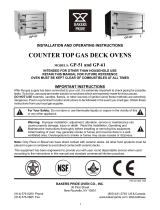
Installation
4
Delivery and Location
DELIVERY AND INSPECTION
All Blodgett ovens are shipped in containers to
preventdamage. Upondeliveryofyournewoven:
D
Inspecttheshippingcontainerforexternaldam-
age. Any evidence of damage should be noted
onthe delivery receiptwhich mustbe signedby
the driver.
D
Uncrate the oven and check for internal dam-
age. Carriers will accept claims for concealed
damage if n otified within fifteen days of delivery
and the shipping container is retained for in-
spection.
The Blodgett Oven Company cannot assume
responsibility for loss or damage suffered in
transit. The carrier assumed full responsibility
for delivery in good order when the shipment
was accepted. We are, however, prepared to
assist you if filing a claim is necessary.
OVEN LOCATION
The well planned and proper placement of your
oven will result in long term operator convenience
and satisfactory performance.
The following clearances must be maintained be-
tween the ovenand any combustible or non-com-
bustible construction.
D
Oven body right s ide --- 6” (15 cm)
D
Oven body left side --- 6” (15 cm)
D
Oven body back --- 6” (15 cm)
D
Oven body bottom --- 4.5” (11.4 cm)
Thefollowingclearancesmustbeavailableforser-
vicing.
D
Oven body sides --- 12” (30 cm)
D
Oven body back --- 12” (30 cm)
NOTE: Ongasmodels,routineservicingcanusu -
ally be accomplished within the limited
movement provided by the gas hose re-
straint. If the oven needs to be moved fur-
ther from the wall, the gas must first be
turned offanddisconnectedfrom theoven
before removing the restraint. Reconnect
the restraint after the oven has been re-
turned to its normal position.
It is essential that an adequate air supply t o t he
oven be maintained to provide a sufficient flow of
combustion and ventilation air.
D
Place the oven in an area that is free of drafts.
D
Keeptheovenareafreeandclearofallcombus-
tiblessuchaspaper,cardboard,andflammable
liquids and solvents.
D
Do not place th e oven on a curb ba se or sealto
awall.Thiswillrestricttheflow ofair andprevent
proper ventilation. Tripping of the blower mo-
tor’s thermal overload device is caused by an
excessive ambient temperature on the right
side of the oven. This condition must be cor-
rected to prevent permanent damage to the
oven.
D
The location must provide adequate clearance
for the air opening into the combustion cham-
ber.
Beforemakinganyutilityconnectionstothisoven,
check t he rating plate to be sure the oven specifi-
cations are compatible with the gas and electrical
services supplied for the oven.
1. Remove the combustion compartment cover.
Theratingplateisattachedtotheframeonthe
left side of the combustion compartment.





















